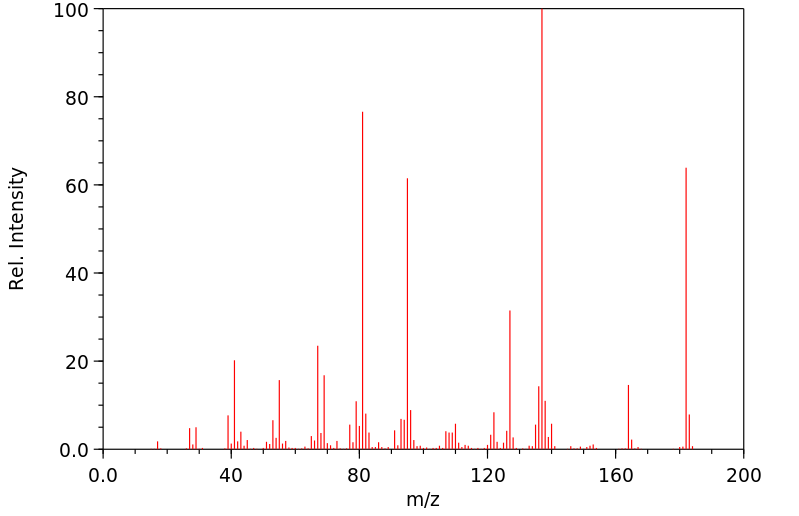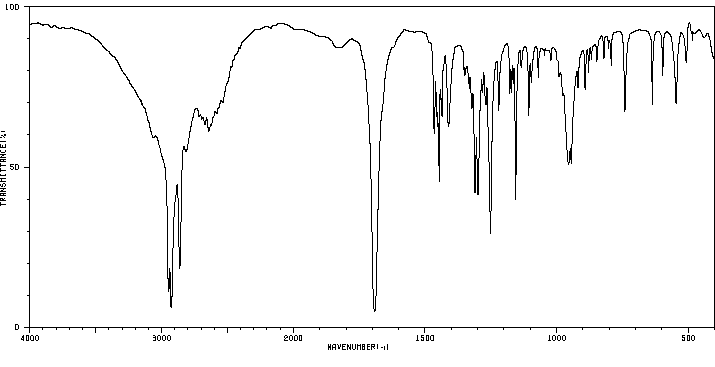cis-decalin-9-carboxylic acid | 3021-73-6
中文名称
——
中文别名
——
英文名称
cis-decalin-9-carboxylic acid
英文别名
cis-bicyclo<4.4.0>decane-1-carboxylic acid;cis-octahydro-naphthalene-4a-carboxylic acid;cis-Octahydro-naphthalin-4a-carbonsaeure;cis-Bicyclo<4.4.0>decan-1-carbonsaeure;(+/-)cis-Decalin-9-carbonsaeure;cis-Decalin-(8a)-carbonsaeure
CAS
3021-73-6
化学式
C11H18O2
mdl
——
分子量
182.263
InChiKey
VAMBVWHKUJPMEB-HOMQSWHASA-N
BEILSTEIN
——
EINECS
——
-
物化性质
-
计算性质
-
ADMET
-
安全信息
-
SDS
-
制备方法与用途
-
上下游信息
-
文献信息
-
表征谱图
-
同类化合物
-
相关功能分类
-
相关结构分类
计算性质
-
辛醇/水分配系数(LogP):2.82
-
重原子数:13.0
-
可旋转键数:1.0
-
环数:2.0
-
sp3杂化的碳原子比例:0.91
-
拓扑面积:37.3
-
氢给体数:1.0
-
氢受体数:1.0
SDS
反应信息
-
作为反应物:参考文献:名称:Haaf,W., Chemische Berichte, 1963, vol. 96, p. 3359 - 3369摘要:DOI:
-
作为产物:参考文献:名称:747.新颖萘烷衍生物的从10β-(1,2-二羟基乙基)的制备-反式-1β-decalol摘要:DOI:10.1039/jr9610003838
文献信息
-
Highly Enantioselective Catalytic Lactonization at Nonactivated Primary and Secondary <i>γ</i>-C–H Bonds作者:Arnau Call、Giorgio Capocasa、Andrea Palone、Laia Vicens、Eric Aparicio、Najoua Choukairi Afailal、Nikos Siakavaras、Maria Eugènia López Saló、Massimo Bietti、Miquel CostasDOI:10.1021/jacs.3c06231日期:2023.8.16Chiral oxygenated aliphatic moieties are recurrent in biological and pharmaceutically relevant molecules and constitute one of the most versatile types of functionalities for further elaboration. Herein we report a protocol for straightforward and general access to chiral γ-lactones via enantioselective oxidation of strong nonactivated primary and secondary C(sp3)–H bonds in readily available carboxylic
-
Radical Amination of C(sp<sup>3</sup>)–H Bonds Using <i>N</i>-Hydroxyphthalimide and Dialkyl Azodicarboxylate作者:Yuuki Amaoka、Shin Kamijo、Tamaki Hoshikawa、Masayuki InoueDOI:10.1021/jo301840e日期:2012.11.16A direct conversion of C(sp(3))-H bonds to C(sp3)-N bonds has been achieved by utilizing catalytic N-hydroxyphthalimide (NHPI) and stoichiometric dialkyl azodicarboxylate. NHPI functions as a precursor of the electron-deficient phthalimide N-oxyl radical (PINO) to abstract hydrogens, and dialkyl azodicarboxylate acts as a trapping agent of the resultant carbon radical to generate the hydrazine derivatives. This C-H amination proceeds in a highly chemoselective manner with a wide applicability to functionalize benzylic, propargylic, and aliphatic C-H bonds. Furthermore, the obtained hydrazine compounds were readily converted to the corresponding carbamates or amines. Hence, the present protocol for direct introduction of the nitrogen functionality serves as a powerful tool for efficient construction of nitrogen-substituted natural products and pharmaceuticals.
-
Carbonylation of aliphatic and cyclic alcohols by carbon monoxide in the presence of complexes of BF3 with acetic, propionic, or monochloroacetic acid作者:S. D. Pirozhkov、K. V. Puzitskii、T. N. Myshenkova、K. G. Ryabova、Ya. T. �idusDOI:10.1007/bf01108192日期:1977.4
-
Koch; Haaf, Justus Liebigs Annalen der Chemie, 1958, vol. 618, p. 251,261作者:Koch、HaafDOI:——日期:——
-
Koch,H.; Haaf,W., Chemische Berichte, 1961, vol. 94, p. 1252 - 1259作者:Koch,H.、Haaf,W.DOI:——日期:——
表征谱图
-
氢谱1HNMR
-
质谱MS
-
碳谱13CNMR
-
红外IR
-
拉曼Raman
-
峰位数据
-
峰位匹配
-
表征信息
同类化合物
(甲基3-(二甲基氨基)-2-苯基-2H-azirene-2-羧酸乙酯)
(±)-盐酸氯吡格雷
(±)-丙酰肉碱氯化物
(d(CH2)51,Tyr(Me)2,Arg8)-血管加压素
(S)-(+)-α-氨基-4-羧基-2-甲基苯乙酸
(S)-阿拉考特盐酸盐
(S)-赖诺普利-d5钠
(S)-2-氨基-5-氧代己酸,氢溴酸盐
(S)-2-[[[(1R,2R)-2-[[[3,5-双(叔丁基)-2-羟基苯基]亚甲基]氨基]环己基]硫脲基]-N-苄基-N,3,3-三甲基丁酰胺
(S)-2-[3-[(1R,2R)-2-(二丙基氨基)环己基]硫脲基]-N-异丙基-3,3-二甲基丁酰胺
(S)-1-(4-氨基氧基乙酰胺基苄基)乙二胺四乙酸
(S)-1-[N-[3-苯基-1-[(苯基甲氧基)羰基]丙基]-L-丙氨酰基]-L-脯氨酸
(R)-乙基N-甲酰基-N-(1-苯乙基)甘氨酸
(R)-丙酰肉碱-d3氯化物
(R)-4-N-Cbz-哌嗪-2-甲酸甲酯
(R)-3-氨基-2-苄基丙酸盐酸盐
(R)-1-(3-溴-2-甲基-1-氧丙基)-L-脯氨酸
(N-[(苄氧基)羰基]丙氨酰-N〜5〜-(diaminomethylidene)鸟氨酸)
(6-氯-2-吲哚基甲基)乙酰氨基丙二酸二乙酯
(4R)-N-亚硝基噻唑烷-4-羧酸
(3R)-1-噻-4-氮杂螺[4.4]壬烷-3-羧酸
(3-硝基-1H-1,2,4-三唑-1-基)乙酸乙酯
(2S,4R)-Boc-4-环己基-吡咯烷-2-羧酸
(2S,3S,5S)-2-氨基-3-羟基-1,6-二苯己烷-5-N-氨基甲酰基-L-缬氨酸
(2S,3S)-3-((S)-1-((1-(4-氟苯基)-1H-1,2,3-三唑-4-基)-甲基氨基)-1-氧-3-(噻唑-4-基)丙-2-基氨基甲酰基)-环氧乙烷-2-羧酸
(2S)-2,6-二氨基-N-[4-(5-氟-1,3-苯并噻唑-2-基)-2-甲基苯基]己酰胺二盐酸盐
(2S)-2-氨基-N,3,3-三甲基-N-(苯甲基)丁酰胺
(2S)-2-氨基-3-甲基-N-2-吡啶基丁酰胺
(2S)-2-氨基-3,3-二甲基-N-(苯基甲基)丁酰胺,
(2S)-2-氨基-3,3-二甲基-N-2-吡啶基丁酰胺
(2S,4R)-1-((S)-2-氨基-3,3-二甲基丁酰基)-4-羟基-N-(4-(4-甲基噻唑-5-基)苄基)吡咯烷-2-甲酰胺盐酸盐
(2R,3'S)苯那普利叔丁基酯d5
(2R)-2-氨基-3,3-二甲基-N-(苯甲基)丁酰胺
(2-氯丙烯基)草酰氯
(1S,3S,5S)-2-Boc-2-氮杂双环[3.1.0]己烷-3-羧酸
(1R,5R,6R)-5-(1-乙基丙氧基)-7-氧杂双环[4.1.0]庚-3-烯-3-羧酸乙基酯
(1R,4R,5S,6R)-4-氨基-2-氧杂双环[3.1.0]己烷-4,6-二羧酸
齐特巴坦
齐德巴坦钠盐
齐墩果-12-烯-28-酸,2,3-二羟基-,苯基甲基酯,(2a,3a)-
齐墩果-12-烯-28-酸,2,3-二羟基-,羧基甲基酯,(2a,3b)-(9CI)
黄酮-8-乙酸二甲氨基乙基酯
黄荧菌素
黄体生成激素释放激素(1-6)
黄体生成激素释放激素 (1-5) 酰肼
黄体瑞林
麦醇溶蛋白
麦角硫因
麦芽聚糖六乙酸酯
麦根酸








